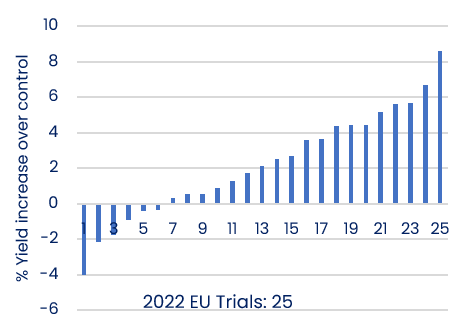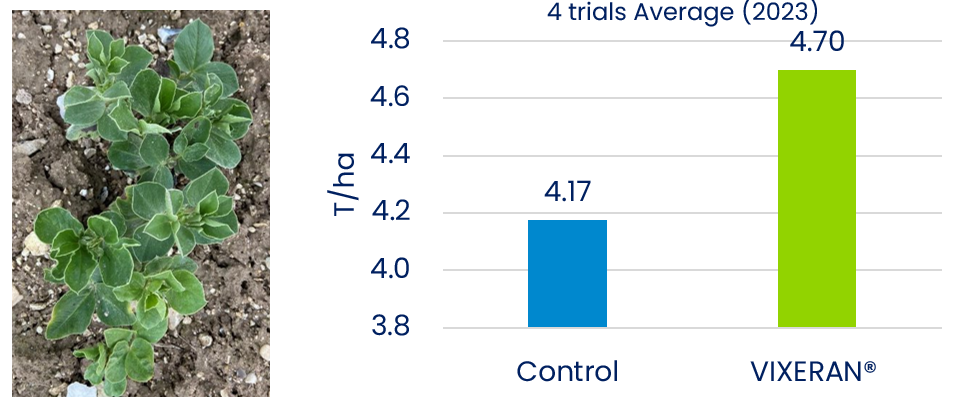VIXERAN®
VIXERAN® is a proven bacteria-based technology that allows your crop to fix nitrogen directly from the atmosphere. This improves nitrogen use efficiency on your farm – whether your crop production is organic or conventional
Fill the gap between the crop's nitrogen supply and demand
There are many situations where it is not possible to meet the nitrogen demand of the plant. Much of the nitrogen added through fertiliser application for example, can be lost to the environment through volatilisation or leaching.
Applied in this peak demand stage, VIXERAN® supplies a reliable source of nitrogen to the crop.
What is VIXERAN®?
VIXERAN® is based on a bacterium called Azotobacter salinestris and is applied as a foliar treatment. Once added, it multiplies across the leaves and the roots, supporting the crops throughout the entire season.
Add a breath of fresh air to your fertiliser strategy.

Inside & Outside
- Free-living nitrogen-fixing bacteria
(Azotobacter salinestris strain CECT 9690) - Lives within the plant or in the soil
Constantly fixing nitrogen from atmosphere
Benefitting plant & rhizosphere

Protects & Surrounds
- Forms cysts to survive hostile conditions
allows a wider range of compatibility with crop protection products - Produces a protective biofilm around the whole plant
Helping to maximise the colonisation process, protecting both plant and bacteria from harsh environmental pressures and harmful phytopathogens

Up & Down
- Colonises the foliage
- Colonises the root system
- Colonising the whole plant gives more consistent benefits
Add a breath of fresh air to your fertiliser strategy
Developed with good agronomic principles
- Proven in multiple environments, locations & crops
- Evidence from R&D & field tests
- Supported by Syngenta´s application & formulation experts
Formulated product for excellent foliar application
- Easy to apply
- Good compatibility
- Rapidly colonises
- Stays working for longer
-
Nitrogen is a KEY macro nutrient needed for growth & development of the crop
Important for chlorophyll production & protein synthesis - 70% of the total N requirement for cereals is needed between GS21-39
-
Conventional cereals will respond to an increase in available soil nitrogen
This is often done through the addition of nitrogen fertilisers -
Applying no more than is required, helps to:-
- Protect the environment
- Reduce the farm carbon footprint
- Improves MOI
This is where VIXERAN® can help
VIXERAN® helps to optimise nitrogen fertiliser management in cereals in 2 ways:
- COMPLEMENT Yield increase in standard nitrogen fertiliser regime
- COMPENSATE Potential yield compensation in nitrogen reduction regime
Trials have shown VIXERAN® can replace around 30 kgN/ha*
VIXERAN® compensatory benefits in wheat
(Reduced N-inputs vs 100% fertiliser)

VIXERAN® complementary benefit in wheat
(100% fertiliser +/- VIXERAN®)

| Strain: | Azotobacter salinestris Strain CECT9690 |
|---|---|
| Formulation: | Solid, powder |
| Dose: | 50 g/ha |
| Time of application: | Apply during periods of active crop growth. Cereals GS21-31 |
| Nitrogen Strategy: | Complement – Can be used with all cereal crops* Compensate – Can be used with all feed quality Cereal crops* |
| Application: | Foliar |
| Action: | Biological N-fixing (leaves / roots / rhizosphere) |
| Shelf-life: | 24 months(at room temperature); longer in cold storage |
*Consult a FACTS Qualified Adviser for advice and guidance on nitrogen applications.Trials have shown VIXERAN® can replace up to 30 kgN/ha based on a reduction from the standard 100% nitrogen RB209 recommendation.
Pulses provide their own nitrogen for growth and development... how can VIXERAN® help?
Understanding the relationship pulses have with the rhizobium in the nodules, highlights why VIXERAN will help!
- Nitrogen fixing nodules are normally formed 3-5 weeks post emergence and start to fix nitrogen as soon as they are formed.
- Around the time of pod filling the nodules will gradually senesce and therefore stop fixing nitrogen.
- However, pulses are a great source protein and the demand for nitrogen is highest exactly when the nodules have senesced off, which means the plant robs the required nitrogen from leaves.
- This saps the plant of its photosynthetic yield building potential.
- By supplementing the nitrogen-need with VIXERAN®, it reduces the burden on the leaves, allowing the plant to carry on photosynthesising and so increasing yield

| Strain: | Azotobacter salinestris Strain CECT9690 |
|---|---|
| Formulation: | Solid, powder |
| Dose: | 50 g/ha |
| Time of application: | Apply during periods of active crop growth. Pulses GS14-60 (Optimum 14-18) |
| Application: | Foliar |
| Action: | Biological N-fixing (leaves/roots/rhizosphere) |
| Shelf-life: | 24 months (at room temperature); longer in cold storage |
VIXERAN® Product Information
To find out more information on the product label, safety data sheet and compatibility list click below
